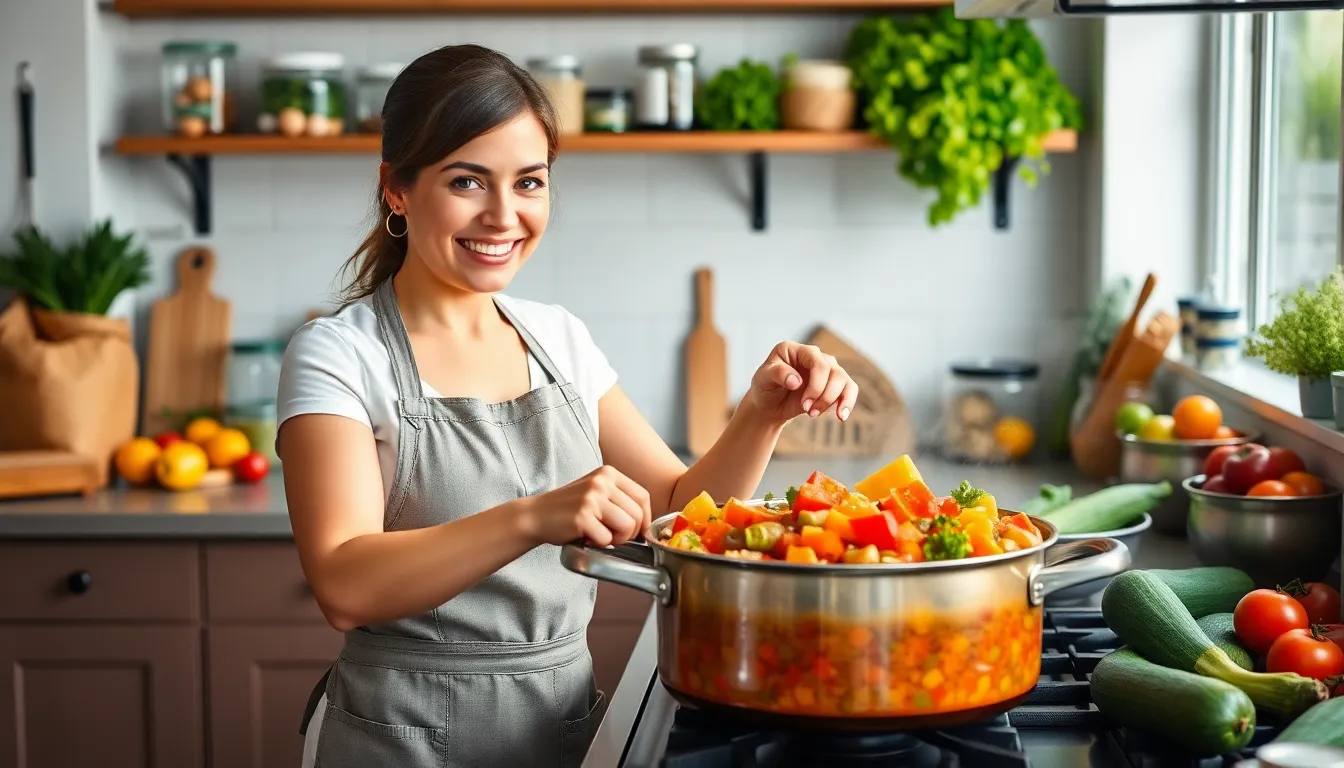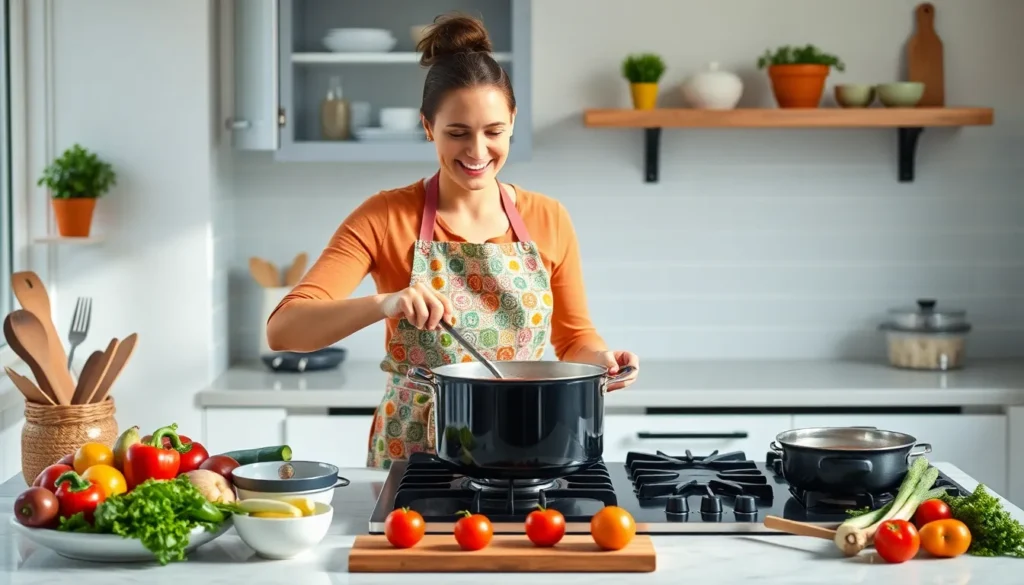Cooking in large batches can feel like a culinary marathon, but it doesn’t have to be a daunting task. Imagine whipping up enough chili to feed a football team or pasta that could rival an Italian feast. With the right tips, not only can he save time and energy, but he can also impress friends and family with his newfound kitchen prowess.
Sure, it might seem overwhelming at first, but think of it as a delicious puzzle waiting to be solved. From mastering meal prep to utilizing smart storage solutions, these tips will turn any home cook into a batch-cooking superstar. So grab that oversized pot and get ready to transform your kitchen into a bustling bistro—who knew cooking could be this much fun?
Tips For Cooking Large Batches
Cooking large batches offers significant advantages for busy individuals and families. These benefits enhance meal preparation efficiency and foster creativity in the kitchen.
Time savings represent a primary benefit of batch cooking. Preparing meals in larger quantities reduces overall cooking time throughout the week. Consequently, this approach allows for more free time, making it easier to enjoy other activities.
Cost-effectiveness often accompanies cooking in bulk. Buying ingredients in larger quantities usually results in lower prices. Shedding light on grocery expenses, batch cooking effectively manages food budgets and minimizes waste.
Enhanced flavor development emerges as another compelling reason to cook in large batches. Allowing dishes to sit for a day or two improves taste. This improvement stems from the melding of flavors, yielding more satisfying meals.
Meal variety can also thrive through batch cooking. With proper planning, one can create different meals from a single base dish. Versatile ingredients provide options for various culinary creations, keeping meal times exciting.
Health benefits further support the case for cooking large batches. Home-cooked meals generally have fewer preservatives and additives, allowing for better nutrition. This focus on wholesome ingredients contributes to improved overall health.
Lastly, convenience stands out as a hallmark of batch cooking. Having ready-to-eat meals simplifies weekdays and provides quick solutions for unexpected events. These aspects help eliminate the last-minute scramble for dinner.
Cooking in large batches streamlines preparation, reduces costs, enhances flavors, and promotes healthier eating. Embracing this strategy transforms the cooking experience into an efficient and rewarding endeavor.
Essential Tips for Cooking Large Batches

Cooking large batches simplifies meal preparation and maximizes efficiency. Following a few essential tips enhances the experience and results.
Planning Your Meals
Prioritize meal planning for successful batch cooking. Start by creating a weekly menu that includes various dishes. List all ingredients needed to minimize waste. Consider dietary preferences and nutritional needs when selecting recipes. Incorporate meals that share ingredients to reduce shopping complexity. Aim for balance by including proteins, vegetables, and grains. This approach not only streamlines cooking but also ensures variety during the week.
Choosing the Right Recipes
Select recipes that adapt well to larger portions. Focus on dishes that freeze well, such as soups, stews, and casseroles. Favor recipes with an extended shelf life for easy storage and reheating. Review cooking times since some recipes may require adjustments when prepared in bulk. Explore one-pot meals to lessen cleanup efforts and enhance flavors. Opt for recipes that allow customization to cater to individual tastes, making everyone happy at mealtime.
Proper Storage Techniques
Utilize proper storage methods to retain freshness and flavor. Invest in high-quality airtight containers to prevent spoilage. Label containers with names and dates for easy identification. Consider portioning meals into single servings for convenient access. Freeze extras within a few hours to maintain quality and prevent freezer burn. Maintain a well-organized freezer and pantry for effortless meal retrieval. Implement these techniques to enjoy the benefits of batch cooking for longer periods.
Cooking Techniques for Large Batches
Home cooks benefit from understanding effective cooking techniques when preparing large batches. Using appropriate methods enhances efficiency and maximizes flavor.
Using the Right Equipment
Investing in suitable kitchen equipment proves essential for batch cooking. A large stockpot accommodates soups and stews easily. Multi-cookers enable versatile meal preparation, offering functions like pressure cooking, slow cooking, and sautéing. Choosing durable, non-toxic containers ensures safe storage of leftovers. Measuring tools help maintain consistent ingredient proportions, promoting flavor balance. Employing a high-quality food processor simplifies chopping, slicing, and pureeing tasks. Selecting the right kitchen equipment leads to successful outcomes in batch cooking.
Managing Cooking Times
Managing cooking times is critical for preparing large batches effectively. Simultaneously cooking multiple items reduces inefficient pauses, allowing for seamless meal prep. Adjusting temperature settings can help control cooking speed across various dishes. Monitoring each dish’s doneness while multitasking prevents overcooking. Utilizing timers assists with keeping track of cooking durations for each component. Prioritizing prepared ingredients based on cooking time allows for smoother preparation and serving. Efficient time management contributes to enjoyable batch cooking experiences.
Common Mistakes to Avoid
Home cooks often overlook the importance of accurate measurements. Inconsistent ingredient amounts can ruin the flavors and textures of batch meals. Failing to account for cooking times can lead to overcooked or undercooked dishes, diminishing the overall quality.
Mismanaging storage is another frequent error. Using improper containers may cause loss of freshness and promote spoilage. Choose airtight, durable options to keep meals safe and flavorful.
Neglecting ingredient compatibility can lead to mixed flavors that don’t mesh well. Recipes that harmonize and share common ingredients yield better results. Selecting suitable recipes ensures a seamless cooking process.
Many overlook the necessity of proper planning. Skipping the meal prep phase might result in wasted ingredients and missed opportunities for flavor development. Establishing a menu helps optimize ingredient usage and simplifies cooking.
Home cooks must also be aware of recipe scaling mistakes. Many underestimate how much a recipe may change when multiplied. Adjusting cooking times, especially for larger amounts, is crucial for achieving consistent textures and flavors.
Rushing through the process frequently leads to mistakes. Taking time to focus on each step can improve results and enjoyment of the cooking experience. Engaging in careful preparation can transform batch cooking from a daunting task into an efficient and rewarding endeavor.
Finally, ignoring the importance of taste testing is detrimental. Frequent sampling ensures the seasonings are balanced and enhances the overall dish quality. Batch cooking should not compromise the joy of flavorful meals.
Conclusion
Embracing the art of batch cooking can transform the way home cooks approach meal preparation. With the right strategies and mindset, it’s possible to create delicious meals that save time and money while enhancing health. By planning effectively and utilizing proper storage techniques, individuals can enjoy a variety of flavorful dishes ready to go whenever hunger strikes.
The joy of cooking in larger quantities not only simplifies weeknight dinners but also fosters creativity in the kitchen. As home cooks refine their skills and learn from their experiences, they’ll find that batch cooking is not just a practical solution but an enjoyable endeavor that brings friends and family together around the table.

